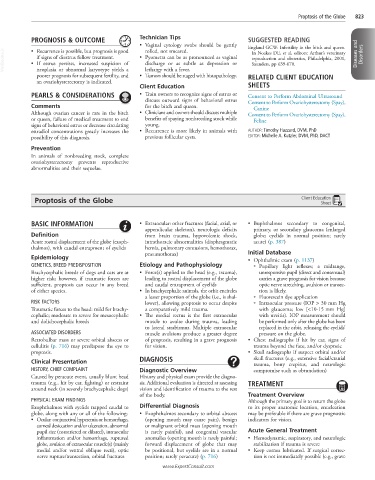Page 1636 - Cote clinical veterinary advisor dogs and cats 4th
P. 1636
Proptosis of the Globe 823
PROGNOSIS & OUTCOME Technician Tips SUGGESTED READING
• Vaginal cytology swabs should be gently England GCW: Infertility in the bitch and queen.
VetBooks.ir • If estrus persists, increased suspicion of • Pyometra can be as pronounced as vaginal In Noakes DE, et al, editors: Arthur’s veterinary Diseases and Disorders
rolled, not smeared.
• Recurrence is possible, but prognosis is good
if signs of diestrus follow treatment.
reproduction and obstetrics, Philadelphia, 2001,
discharge or as subtle as depression or
Saunders, pp 639-670.
neoplasia or abnormal karyotype yields a
lethargy with a fever.
poorer prognosis for subsequent fertility, and • Tumors should be staged with histopathology. RELATED CLIENT EDUCATION
an ovariohysterectomy is indicated.
Client Education SHEETS
PEARLS & CONSIDERATIONS • Train owners to recognize signs of estrus or Consent to Perform Abdominal Ultrasound
discuss outward signs of behavioral estrus Consent to Perform Ovariohysterectomy (Spay),
Comments for the bitch and queen. Canine
Although ovarian cancer is rare in the bitch • Clinicians and owners should discuss multiple Consent to Perform Ovariohysterectomy (Spay),
or queen, failure of medical treatment to end benefits of spaying nonbreeding stock while Feline
signs of behavioral estrus or decrease circulating young.
estradiol concentrations greatly increases the • Recurrence is more likely in animals with AUTHOR: Timothy Hazzard, DVM, PhD
possibility of this diagnosis. previous follicular cysts. EDITOR: Michelle A. Kutzler, DVM, PhD, DACT
Prevention
In animals of nonbreeding stock, complete
ovariohysterectomy prevents reproductive
abnormalities and their sequelae.
Proptosis of the Globe Client Education
Sheet
BASIC INFORMATION • Extraocular: other fractures (facial, axial, or • Buphthalmos secondary to congenital,
appendicular skeleton), neurologic deficits primary, or secondary glaucoma (enlarged
Definition from brain trauma, hypovolemic shock, globe; eyelids in normal position; rarely
Acute rostral displacement of the globe (exoph- intrathoracic abnormalities (diaphragmatic acute) (p. 387)
thalmos), with caudal entrapment of eyelids hernia, pulmonary contusions, hemothorax,
pneumothorax) Initial Database
Epidemiology • Ophthalmic exam (p. 1137)
GENETICS, BREED PREDISPOSITION Etiology and Pathophysiology ○ Pupillary light reflexes; a midrange,
Brachycephalic breeds of dogs and cats are at • Force(s) applied to the head (e.g., trauma), unresponsive pupil (direct and consensual)
higher risk; however, if traumatic forces are leading to rostral displacement of the globe carries a grave prognosis for vision because
sufficient, proptosis can occur in any breed and caudal entrapment of eyelids optic nerve stretching, avulsion or transec-
of either species. • In brachycephalic animals, the orbit encircles tion is likely.
a lesser proportion of the globe (i.e., is shal- ○ Fluorescein dye application
RISK FACTORS lower), allowing proptosis to occur despite ○ Intraocular pressure (IOP > 30 mm Hg
Traumatic forces to the head: mild for brachy- a comparatively mild trauma. with glaucoma; low [<10-15 mm Hg]
cephalic; moderate to severe for mesocephalic • The medial rectus is the first extraocular with uveitis). IOP measurement should
and dolichocephalic breeds muscle to avulse during trauma, leading be performed only after the globe has been
to lateral strabismus. Multiple extraocular replaced in the orbit, releasing the eyelids’
ASSOCIATED DISORDERS muscle avulsions produce a greater degree pressure on the globe.
Retrobulbar mass or severe orbital abscess or of proptosis, resulting in a grave prognosis • Chest radiographs if hit by car, signs of
cellulitis (p. 716) may predispose the eye to for vision. trauma beyond the face, and/or dyspneic
proptosis. • Skull radiographs if suspect orbital and/or
Clinical Presentation DIAGNOSIS skull fractures (e.g., extensive facial/cranial
trauma, bony crepitus, and neurologic
HISTORY, CHIEF COMPLAINT Diagnostic Overview compromise such as obtundation)
Caused by peracute event, usually blunt head History and physical exam provide the diagno-
trauma (e.g., hit by car, fighting) or restraint sis. Additional evaluation is directed at assessing TREATMENT
around neck (in severely brachycephalic dogs) vision and identification of trauma to the rest
of the body. Treatment Overview
PHYSICAL EXAM FINDINGS Although the primary goal is to return the globe
Exophthalmos with eyelids trapped caudal to Differential Diagnosis to its proper anatomic location, enucleation
globe, along with any or all of the following: • Exophthalmos secondary to orbital abscess may be preferable if there are grave prognostic
• Ocular: conjunctival hyperemia or hemorrhage, (opening mouth may cause pain), benign indicators for vision.
corneal desiccation and/or ulceration, abnormal or malignant orbital mass (opening mouth
pupil size (constricted or dilated), intraocular is rarely painful), and congenital vascular Acute General Treatment
inflammation and/or hemorrhage, ruptured anomalies (opening mouth is rarely painful; • Hemodynamic, respiratory, and neurologic
globe, avulsion of extraocular muscle(s) (mainly forward displacement of globe that may stabilization if trauma is severe
medial and/or ventral oblique recti), optic be positional, but eyelids are in a normal • Keep cornea lubricated. If surgical correc-
nerve rupture/transection, orbital fractures position; rarely peracute) (p. 716) tion is not immediately possible (e.g., grave
www.ExpertConsult.com

